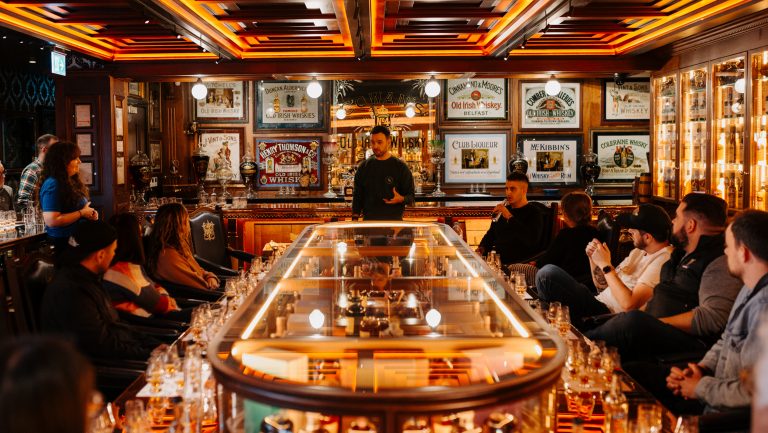There’s a parable in Franz Kafka’s novel The Trial about a man who attempts to be admitted before the “Law,” depicted as a manned gate behind which, he’s told, is a series of increasingly impenetrable portals. For the rest of his life, the man tries but fails to cross the threshold. In the United States, the Alcohol and Tobacco Tax and Trade Bureau, better known as the TTB, is also a seemingly impassable gatekeeper, but for spirits.
The TTB was established in 2003, split from the Bureau of Alcohol, Tobacco, Firearms and Explosives during the federal government’s post-9/11 reorganization. Among its responsibilities, it publishes the Beverage Alcohol Manual, which divides spirits into classes and types. Whereas class refers to a spirit category such as whiskey or brandy, type indicates such subcategories as bourbon or pisco. These legal standards exist to “prevent misleading labeling and advertising,” according to the TTB. Yet by this standard, the TTB falls short.
The No-Man’s-Land of Spirits
At present, large swathes of the liquor world are functionally invisible to the TTB. Most of its taxonomy was adopted from standards that predate the organization, and spirits of European origin are predominant. More than 40 types of whisky are included, and, although genever isn’t represented, aquavit curiously is. Baijiu, the world’s largest spirits category by volume and value, is not a recognized class, nor are its East Asian cousins, Japanese shochu and Korean soju. Colombian aguardiente? No. Even the famously diverse rum class makes no allowance for individual types other than cachaça.

Don’t miss the latest drinks industry news and insights. Sign up for our award-winning newsletters and get insider intel, resources, and trends delivered to your inbox every week.
The limited taxonomy means that all unclassified liquors are lumped into a nebulous class called Distilled Spirits Specialty, which requires labels that identify ingredients instead of listing category names. Such requirements may seem trivial, but these unrecognized spirits operate at a disadvantage in the U.S. market, because without that name front and center, branding opportunities are diminished.
Shochu and awamori expert Christopher Pellegrini finds it “frustrating” to ready these products for the States. “It’s 600 years of doing something a certain way,” he says. “A lot of that heritage is not automatically respected. You can write the blurb on the back, but there’s only so much space.”
Mitigating confusion is an even bigger challenge. Consumers, the TTB suggests, should have confidence that what’s inside the bottle accurately reflects what’s printed on the outside. Unfortunately, a lack of definition for several spirit classes has caused problems. In 1998, California allowed restaurants to sell soju under 24 percent ABV without a liquor license. Subsequently, enterprising Japanese distillers began labeling their shochu products “soju” to take advantage of the loophole, and “soju” that is really shochu is now widespread in the U.S. The linguistic similarity between the two categories all but guarantees that the confusion will exist for years to come.
Then there’s baijiu. “Baijiu is the most consumed spirit in the world, and I find it strange that the TTB doesn’t recognize it as a major category,” says Michelle Ly, co-owner of Vinn Baijiu. “Baijiu has a specific process of fermentation and distillation, so having some rules identified will help,” she believes, by informing customers as to what they are buying.
A Chance for Progress
In November 2018, the TTB announced an exploratory series of reforms and allowed the public to submit comments. “The idea of it was to be inclusive, to digest those comments and work with the industry to make sure that they were more in touch with what was actually happening,” says Jerald O’Kennard, who, as director of the Beverage Testing Institute, works regularly with the TTB and finds it a responsive organization.
Among the proposed changes was a rule to prohibit “cross-commodity terms that the TTB considered to be misleading” and specifically forbid any language that may confuse consumers. Presumably, these changes would address key concerns among uncategorized spirits producers while creating an impetus for expanding recognition of new categories.
The measure received opposition from a Louisiana senator and a number of industry organizations, including the Distilled Spirits Council of the United States (DISCUS), suggesting that the new rules would inhibit creativity and cause an undue relabeling burden. Ultimately, the TTB rejected the proposed amendment, and what O’Kennard calls “a once in a lifetime opening of the doors” was shut.
One remaining path for recognition of on-the-margin spirits categories is the creation of new TTB classes and types. Yet, since the TTB’s inception, only one spirit type, Brazil’s cachaça, has been introduced into the spirits manual. Three other classes and types have been amended or reclassified: ouzo, aquavit, and pisco. Andong soju is now recognized as a Korean product, though public records do not indicate that a general soju class has been created. In January, the TTB announced that Bolivian singani will soon be considered for inclusion as a new type of brandy.
It’s Political
What these cases have in common is high-level political intervention. Ouzo was amended from a type of liqueur/cordial after the Greek embassy informed the TTB that in Greece ouzo must be less than 2.5 percent sugar, making it definitionally incompatible with a liqueur, which must contain more than 2.5 percent sugar. When the TTB announced changes to the status of Andong soju, cachaça, and singani, the U.S. government required reciprocal recognition of Tennessee and bourbon whiskies as unique American products in Korea, Brazil, and Bolivia, respectively.
“If a country wants its spirit to be recognized by the U.S., they must have something to offer in exchange,” says global cachaça ambassador and consultant Mauricio Maia. Brazil began seeking TTB recognition for cachaça in the early 2000s, and the Obama administration offered it as a sweetener to a 2012 trade deal.
Singani appears to be a far less likely candidate for individual recognition. The U.S. market for cachaça exports from Brazil was valued at $3.68 million in 2018, compared to around $195,000 for Bolivian singani that same year. But singani has one advantage most esoteric spirits lack: star power.
Director Steven Soderbergh, who launched his own brand, Singani 63, in 2015, initiated a plan of action to have the TTB recognize singani. He enlisted consultant Steve Raye, president of Bevology Inc., and Bill Earle, then-president of the National Association of Beverage Importers, and the team drafted a petition to the TTB, commissioned tests to demonstrate the differences between singani and Cognac, and met with the TTB. Soderbergh even obtained the official blessing of Bolivia’s then-president, Evo Morales. But Morales’s government was at odds with American foreign policy, and the U.S. was not inclined to strike a deal. Only when Morales resigned was the proposed TTB rule change for singani announced.
“We expect any day that the TTB will approve it,” says Raye, “so we are standing right outside the door.”
What a Fair Solution Could Look Like
Although the TTB “is the implementer and the rule maker,” explains Earle, who now runs his own consultancy, Enjoying the Journey, “it’s really a matter of diplomatic dialogue, and it rises to the level of negotiating a trade agreement.” In order to effect change, it’s necessary to have compliance from the State Department and the Office of the United States Trade Representative in addition to the TTB’s support.
As it stands now, it seems that the process of changing TTB classifications has more to do with political expediency than other factors. As a result, consumer clarity suffers. By contrast, a simple application process for class and type recognition, with clearly outlined filing requirements, might result in more petitions, but it would also address many of the status quo’s obvious shortcomings. This mechanism would require a greater degree of industry coordination.
“It’s incumbent on producers to get together and say, ‘Here’s what we’re doing. These are the norms and standards of it,’” says O’Kennard. “If they can do that, I think they’re much more likely to have success. Without it, I don’t see the impetus for the TTB to change because the industry hasn’t really sorted it out for themselves.”
Until the industry works in a more collaborative way, the TTB’s Beverage Alcohol Manual will remain an exclusive club of mostly European spirits, inaccessible to all but a handful of outsiders. Confused consumers and frustrated producers will have to drown their sorrows in specialty spirits distilled from grain.

Dispatch
Sign up for our award-winning newsletter
Don’t miss the latest drinks industry news and insights—delivered to your inbox every week.
Derek Sandhaus has written several books on Chinese history and culture, including Baijiu: The Essential Guide to Chinese Spirits and Drunk in China: Baijiu and the World’s Oldest Drinking Culture. He is a cofounder of Ming River Sichuan Baijiu and currently serves as the brand’s communications director. He is also the editor of DrinkBaijiu.com. He lives in Washington, D.C.







